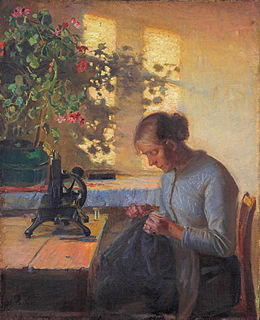 W
WSewing is the craft of fastening or attaching objects using stitches made with a needle and thread. Sewing is one of the oldest of the textile arts, arising in the Paleolithic era. Before the invention of spinning yarn or weaving fabric, archaeologists believe Stone Age people across Europe and Asia sewed fur and skin clothing using bone, antler or ivory needles and "thread" made of various animal body parts including sinew, catgut, and veins.
 W
WIn modern clothing and fashion design, a button is a small fastener, now most commonly made of plastic but also may be made of metal, wood, or seashell, that joins two pieces of fabric together. In archaeology, a button can be a significant artifact. In the applied arts and in craft, a button can be an example of folk art, studio craft, or even a miniature work of art.
 W
WA coverstitch is formed by two or more needles which add straight stitches to the fabric and a looper thread on the opposite side of the fabric that zig-zags between the straight stitches. A coverstitch results in parallel lines of straight stitches on one side of the fabric and an overcast stitch on the reverse side. It is widely used in garment construction, particularly for attaching trims and flat seaming where the raw edges can be finished in the same operation as forming the seam.
 W
WA dressmaker is a person who makes custom clothing for women, such as dresses, blouses, and evening gowns. A dressmaker is also called a mantua-maker (historically), modiste, or fabrician.
 W
WEisaku Noro Company, Ltd. is a yarn manufacturer located in the Aichi Prefecture of Japan. The company produces yarns for handcrafting under the Noro brand name, as well as machine yarns for textile production using the Eisaku Noro label. The company was founded over forty years ago by Eisaku Noro. The handcrafting yarns in particular are well known for their vivid colors and combinations of diverse fiber types. They differ from a number of other manufactured yarns in the industry by having lengthier spans of color in the runs, causing distinctive striping patterns, as well as being partially spun by hand versus being produced completely by machines. In 2012, Noro Knitting Magazine initiated publication, which features knit and crochet patterns specifically designed for use with the yarns.
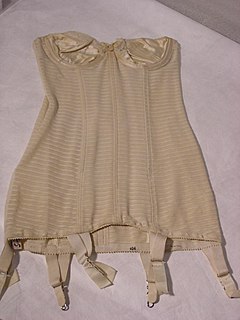 W
WIn sewing, elastic is a notion which is sold in narrow strips and generally serves to increase the ability of garment to stretch, either to accommodate movement or to make the garment suitable for wearers of many different physical sizes. Elastic comes in four forms forms of construction, each with costs and benefits. The component which performs the actual stretching is made of either rubber or a synthetic material such as spandex; this stretching component is then covered with polyester, cotton, nylon, or a combination of these or other fibers which allow it to be attached to clothing. High-quality elastic is able to be stretched to twice its original length and then return to its unflexed state without showing appreciable wear.
 W
WIn sewing and crafts, an embellishment is anything that adds design interest to the piece.
 W
WAn embroidered patch, also known as a cloth badge, is a piece of embroidery which is created by using a fabric backing and thread. The art of making embroidered patches is an old tradition and was originally done by hand. During the first half of the twentieth century they were commonly embroidered using a shiffli embroidery machine. High-speed, computerized machines have led to mass production.
 W
WThe term "eye of a needle" is used as a metaphor for a very narrow opening. It occurs several times throughout the Talmud. The New Testament quotes Jesus as saying that "it is easier for a camel to go through the eye of a needle than for a rich man to enter the kingdom of God". It also appears in the Qur'an 7:40, "Indeed, those who deny Our verses and are arrogant toward them - the gates of Heaven will not be opened for them, nor will they enter Paradise until a camel enters into the eye of a needle. And thus do We recompense the criminals."
 W
WIn sewing and tailoring, facing is a small piece of fabric, separate or a part of the fabric itself, used to finish the fabric edges. Facing makes a garment look professionally finished with the seams well hidden inside the folds of the facing. Facing is mostly used to finish the edges in necklines, armholes, hems and openings. They are also used widely in all other sewing like quilts and home decor items like curtain hems.
 W
WFeed sack dresses, flour sack dresses, or feedsack dresses were a common article of clothing in rural US and Canadian communities from the late 19th century through the mid 20th century. They were made at home, usually by women, using the cotton sacks in which flour, sugar, animal feed, seeds, and other commodities were packaged, shipped, and sold. They became an iconic part of rural life from the 1920s through the Great Depression, World War II, and post-World War II years.
 W
WFelled seam, or flat-fell seam, is a seam made by placing one edge inside a folded edge of fabric, then stitching the fold down. The fold encases the raw edges protects them from fraying. The fold may be secured with a topstitch or a whipstitch. It is useful for keeping seam allowances flat and covering raw edges.
 W
WGathering is a sewing technique for shortening the length of a strip of fabric so that the longer piece can be attached to a shorter piece. It is commonly used in clothing to manage fullness, as when a full sleeve is attached to the armscye or cuff of a shirt, or when a skirt is attached to a bodice.
 W
WGimp is a narrow ornamental trim used in sewing or embroidery. It is made of silk, wool, polyester, or cotton and is often stiffened with metallic wire or coarse cord running through it. Gimp is used as trimming for dresses, curtains, furniture, etc. Originally the term referred to a thread with a cord or wire in the center, but now is mainly used for a trimming braided or twisted from this thread. Sometimes gimp is covered in beads or spangles.
 W
WA godet is an extra piece of fabric in the shape of a circular sector which is set into a garment, usually a dress or skirt. The addition of a godet causes the article of clothing in question to flare, thus adding width and volume. The most popular use of godets is in petticoats. Adding a godet to a piece of clothing also gives the wearer a wider range of motion.
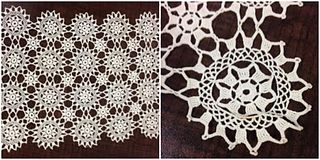 W
WGreek lace is considered one of the earliest forms of all lace. Some types of Greek lace include reticella, Roman lace, cutwork, Venetian guipure, and Greek point lace
 W
WIn sewing, a gusset is a triangular or rhomboidal piece of fabric inserted into a seam to add breadth or reduce stress from tight-fitting clothing. Gussets were used at the shoulders, underarms, and hems of traditional shirts and chemises made of rectangular lengths of linen to shape the garments to the body.
 W
WA hem in sewing is a garment finishing method, where the edge of a piece of cloth is folded and sewn to prevent unravelling of the fabric and to adjust the length of the piece in garments, such as at the end of the sleeve or the bottom of the garment.
 W
WThe hemline is the line formed by the lower edge of a garment, such as a skirt, dress or coat, measured from the floor.
 W
WInterfacing is a textile used on the unseen or "wrong" side of fabrics to make an area of a garment more rigid.
 W
WIn sewing and tailoring, a lining is an inner layer of fabric, fur, or other material inserted into clothing, hats, luggage, curtains, handbags and similar items.
 W
WA drawing pin or thumb tack is a short nail or pin used to fasten items to a wall or board for display and intended to be inserted by hand, usually using the thumb. A variety of names are used to refer to different designs intended for various purposes.
 W
WIn sewing and haberdashery, notions are small objects or accessories, including items that are sewn or otherwise attached to a finished article, such as buttons, snaps, and collar stays. Notions also include the small tools used in sewing, such as needles, thread, pins, marking pens, elastic, and seam rippers. The noun is almost always used in the plural. The term is chiefly in American English. It was also formerly used in the phrase "Yankee notions", meaning American products. A fabric store will have a section or department devoted to notions, and a spool of thread is considered a notions, but one cannot ask to "purchase a notions" without greater specificity as to which one.
 W
WAn overlock is a kind of stitch that sews over the edge of one or two pieces of cloth for edging, hemming, or seaming. Usually an overlock sewing machine will cut the edges of the cloth as they are fed through, though some are made without cutters. The inclusion of automated cutters allows overlock machines to create finished seams easily and quickly. An overlock sewing machine differs from a lockstitch sewing machine in that it uses loopers fed by multiple thread cones rather than a bobbin. Loopers serve to create thread loops that pass from the needle thread to the edges of the fabric so that the edges of the fabric are contained within the seam.
 W
WPassementerie or passementarie is the art of making elaborate trimmings or edgings of applied braid, gold or silver cord, embroidery, colored silk, or beads for clothing or furnishings.
 W
WIn sewing and fashion design, a pattern is the template from which the parts of a garment are traced onto fabric before being cut out and assembled. Patterns are usually made of paper, and are sometimes made of sturdier materials like paperboard or cardboard if they need to be more robust to withstand repeated use. The process of making or cutting patterns is sometimes condensed to the one-word Patternmaking, but it can also be written pattern(-)making or pattern cutting.
 W
WIn sewing, piping is a type of trim or embellishment consisting of a strip of folded fabric so as to form a "pipe" inserted into a seam to define the edges or style lines of a garment or other textile object. Usually the fabric strip is cut on the bias. It may be made from either self-fabric or contrasting fabric, or of leather.
 W
WPiteado is an artisan technique where pita or ixtle is embroidered onto leather in decorative patterns. The technique is used to make belts, sandals, hair bands, saddles, and other leather accessories. The technique is popular in Mexico and Central America, and typical designs include flowers, animals, charreada, and Pre-Hispanic symbols.
 W
WA pleat is a type of fold formed by doubling fabric back upon itself and securing it in place. It is commonly used in clothing and upholstery to gather a wide piece of fabric to a narrower circumference.
 W
WIn sewing and dressmaking, a ruffle, frill, or furbelow is a strip of fabric, lace or ribbon tightly gathered or pleated on one edge and applied to a garment, bedding, or other textile as a form of trimming.
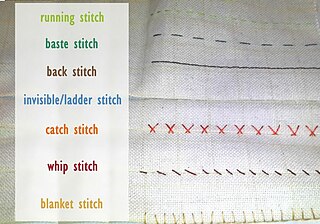 W
WA whip stitch is a simple sewing stitch that is used in crocheting, knitting and sewing, and in which the needle is passed in and out of the fabric in a series of stitches that circle an edge of the fabric. In hand sewing, this stitch can be used to create a seam but can also be used for joining two felt pieces together. Whip stitching creates a nice edge and prevents the fabric from unraveling.
 W
WThe term sewing circle usually refers to a group of people, usually women, who meet regularly for the purpose of sewing, often for charitable causes while chatting, gossiping, and/or discussing.
 W
WA sewing gauge is a ruler, typically 6 inches long, used for measuring short spaces. It is typically a metal scale, marked in both inches and centimeters with a sliding pointer, similar in use to a caliper. It is used to mark hems for alterations as well as intervals between pleats and buttonholes and buttonhole lengths. It can be also used as a compass to draw arcs and circles by anchoring the slider with a pin and placing the tip of a marking pencil in the hole located at the end of the scale. Some models also incorporate a button shank and a blunt point for turning corners right side out.
 W
WIn the textile arts, a stitch is a single turn or loop of thread, or yarn. Stitches are the fundamental elements of sewing, knitting, embroidery, crochet, and needle lace-making, whether by hand or machine. A variety of stitches, each with one or more names, are used for specific purposes.
 W
WA tailor is a person who makes, repairs, or alters clothing professionally, especially suits and men's clothing.
 W
WTopstitching is a sewing technique where the line of stitching is designed to be seen from the outside of the garment, either decorative or functional.
 W
WThe Torrington Company was a firm that developed in Torrington, Connecticut, emerging as a rename from the Excelsior Needle Company. It used a "cold swaging" technique to create sewing machine needles and other needles from cold metal, and was the largest employer in Torrington. in addition to its main facilities in Torrington, it acquired a division, located in South Bend, Indiana.
 W
WTrim or trimming in clothing and home decorating is applied ornament, such as gimp, passementerie, ribbon, Ruffle (sewing)s, or, as a verb, to apply such ornament.
 W
WIn sewing, a tuck is a fold or pleat in fabric that is sewn or fastened in place.
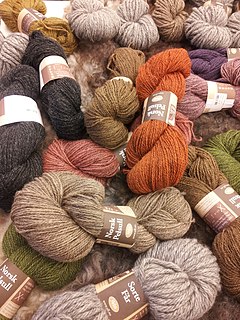 W
WYarn is a long continuous length of interlocked fibres, suitable for use in the production of textiles, sewing, crocheting, knitting, weaving, embroidery, or ropemaking. Thread is a type of yarn intended for sewing by hand or machine. Modern manufactured sewing threads may be finished with wax or other lubricants to withstand the stresses involved in sewing. Embroidery threads are yarns specifically designed for needlework.